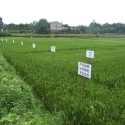06 Nov 2012
Effect of long-term fertilization on the persistence of cypermethrin in soil

Currently, there is interest in the relationship between the biodegradation of pesticides and fertilization. Many studies have shown that the addition of organic manure and N and P fertilizers can affect pesticide degradation in soils (Topp et al., 1996; Han et al., 2003; Caracciolo et al, 2005). However, little is known about the interaction between longterm fertilization and pesticide dissipation. This study investigated cypermethrin dissipation in soils under five different long-term fertilization treatments.
Cypermethrin is a pyrethroid insecticide used to control certain insect pests. It is increasingly used for agriculture and commercial pest control, given that organochlorine and some organophosphate products are being phased out. Cypermethrin has been found in soils, sediments, and even foodstuffs, and recent studies have shown that cypermethrin possesses carcinogenic and co-carcinogenic potential and endocrine activities (Tyler et al., 2000; Shukla et al., 2002). These health impacts, combined with cypermethrin’s high toxicity to aquatic life (Solomon et al., 2001), places great significance of the study of cypermethrin’s behavior and fate in the environment.
Beginning in September of 1989, a long-term field experiment was established to determine the influence of mineral fertilizer and organic manure on soil fertility, with a crop rotation of wheat and maize. The site was part of the Key Experimental Station for Ecological Agriculture, Fengqiu County, Henan Province. The soil in this area was derived from alluvial sediments of the Yellow River, and is classified as aquic inceptisol. It has a sandy loam texture (about 9% clay, 22% silt). This study involved five treatments including N, P, and K (NPK); N and K without P (NK); P and K without N (PK); organic compost was applied without inorganic fertilizers (OM); and no fertilization (control). The application rates of N, P, and K, if applied, were the same in all treatments at 150 kg N/ha, 75 kg P2O5/ha, and 150 kg K2O/ha for winter wheat; and 150 kg N/ha, 60 kg P2O5/ha, and 150 kg K2O/ha for maize. Soil samples were collected from the surface layer (0 to 20 cm in depth) of each plot in April, 2005. The soil was sieved through a 2 mm screen to remove the roots and stored at 4 ℃in plastic bags until analyzed.
Soil pH, organic carbon, total N, total P, available N, available P, and available K were determined as described by Lu (2000). All treatments were assessed using fresh soil samples equivalent to 20 g of dry soil and the water content in the soil was adjusted to 60% of soil water-holding capacity.
Three replicates of soil from each treatment were amended with cypermethrin (purity >96%, Sigma) and dissolved in acetone (0.5 mL) to obtain a pesticide concentration of 10 mg/kg. Next, the pesticide was distributed homogeneously. The soils amended with cypermethrin were placed in beakers, covered with perforated aluminum foil to ensure gas exchange, and then incubated at 25C. Soil moisture content was maintained constant throughout the entire incubation period. After 4, 7, 14, 21, and 28 days, soil samples were collected to determine the residue concentrations. The analyses of cypermethr in residues in soils were performed using an Aglient 6820 gas chromatograph equipped with an electron capture detector and an HP-5 MS capillary column based on the method reported by Sannino et al. (2003).
Soil physicochemical properties varied significantly after applying different fertilizers over a long period of time (Table 1). The OM treatment had the highest organic carbon, available P, and total N contents, but the lowest pH. The lowest total and available N, P, or K contents were found in the treatments that omitted N, P, or K. Overall, higher soil N, P, and organic carbon contents were observed in treatments receiving OM or NPK.
Cypermethrin dissipation in non-sterilized soils over a 28 day period is shown in Figure 1. In the first 4 days, cypermethrin dissipated slowly. Dissipation was especially slow within the OM treatment compared to other treatments. From day 4 to day 21, cypermethrin dissipated faster, and with the exception of the NK treatment, more than 80% had transformed in the soils by the end of the incubation period.
The dissipation patterns of cypermethrin fit first order kinetics, C = C0e-kt (Beulke and Brown, 2001). The half-lives for the different treatments were 9.6 days for PK, 10.7 days for control, 10.8 days for OM, 11.8 days for NPK, and 15.1 days for NK (Table 2). Thus the half-life for cypermethrin within the NK treatment was significantly longer than those for other treatments. Cypermethrin dissipated faster in the PK and control treatments and no significant difference was found between these two treatments. There was no significant difference in the dissipation of cypermethrin between long-term fertilization with composted organic manure versus inorganic NPK fertilization.
A correlation test was conducted between the cypermethrin half-lives and soil properties. There was a strong positive relationship between the cypermethrin half-life and the N/P ratio (soil available N to soil available P ratio; r=0.926, p=0.012) and a similar positive correlation was found with soil available N (r=0.846, p=0.035). This relationship suggests that long-term fertilization without P, or with high levels of N, can increase soil N/P ratios and available N content, and thus inhibit the dissipation of cypermethrin. This result is consistent with reports by Graham et al. (1999), Caracciolo et al. (2005) and Entry (1999). Total and available P content were negatively correlated with cypermethrin half-life, but not to a significant degree, and could enhance degradation to some extent. Soil organic carbon was weakly correlated with cypermethrin half-life in soil.
Conclusion
In the long-term, different fertilization strategies have a significant effect on soil physicochemical properties. Soil organic carbon content was higher in soils with balanced fertilization, especially fertilization with composted organic manure, than in soils with unbalanced fertilization. Soil N and P contents also varied greatly in soils with different fertilization treatments.
Cypermethrin persistence also differed significantly among soils with different modes of fertilization in this longterm study. Cypermethrin dissipated faster in soils fertilized with PK and in the control. The slowest dissipation was observed in the NK treatment. No significant difference in dissipation was observed between long-term fertilization with inorganic NPK and fertilization with organic manure. Soil
N/P ratio and available N content showed significant positive correlation with cypermethrin half-life (p<0.05), and could inhibit cypermethrin dissipation. Total soil P and available P content showed a non-significant negative correlation with the pesticide half-life and may enhance dissipation to some
extent. These results can help us to establish scientific modes of fertilization and to predict the fate of cypermethrin in soils and minimize environmental risks.




